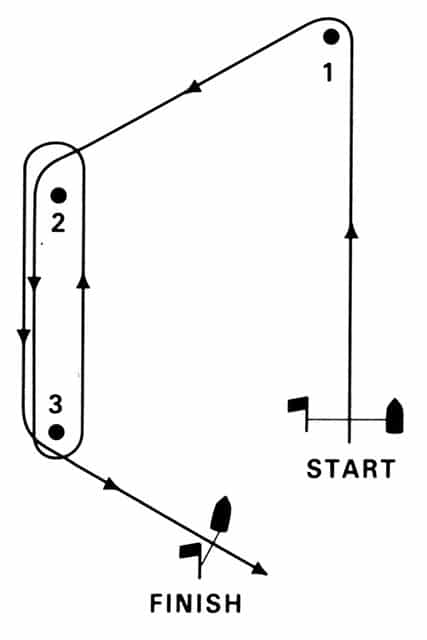
trapezoid
Given the choice, I’d take a lightweight skiff over a leaden full-keel classic any day. I’m still too young, and life’s too short to go slow. I do, however, have a slight problem with the sporty craft we race nowadays: On our typical windward-leeward racecourse, there’s far too much upwind work for too little downwind play. I want more planing, less plodding.
We’re ultimately about going fast, right? We constantly measure our ability against “the numbers”—those black digits on our display, Speedpuck, or GPS, that tell us what we’re capable of in a Force 5 breeze and, indirectly, how much fun we’re having. And when we’re talking about numbers these days, we’re talking decimals—every little fraction counts when pegging a personal best on the speedo.
I realize “fast” is a relative term, measured against one’s comfort level or the type of boat one races. Fast in a classic might be 4 knots, or 4.5 knots if you’re lucky, and that can be exhilarating. In skiffs, sportboats, and foiling dinghies, it’s teens we’re striving for—anything less is simply slow.
With our boats being lighter, faster, and more efficient, we’ve entered into an awesome era of sailing. The Volvo Ocean Race guys hardly blink at 30 anymore. Only when they’re sliding down a wave face at 40 do they talk of fear factor. The AC45 teams of the America’s Cup World Series can do 30 knots without trying, and who knows what an AC72 will be capable of when the governor comes off next summer. Will we be talking 40? 50? I’m sure the designers know, and I can’t wait to see where that redline falls.
To grasp how far performance sailing has come, one need only consider Tim Colman’s proa Crossbow I (p. 14 of our September 2012 issue), which hit 25 knots in 1975, and that was as good as they could get out of their special-purpose speedster. Fast-forward to today: Foilers and kites are regularly cracking the 50-knot barrier. Tomorrow it’ll be 60 knots or more.
Even at the ground level where most of us play, double-digit speeds are a regular occurrence. We’re happily pushing our boats and confidence past our comfort zone. It’s what excites us and gives us stories to share at the bar. I was reminded of this when Gary Jobson proposed to me that he write his column (p. 16 of our September 2012 issue) about his recent experience of sailing the Bermuda Race onboard the Reichel/Pugh 65 Kodiak (née-Blue Yankee). What struck me was, for a guy who has logged thousands of miles on so many different boats, this single experience of gliding across wave tops on a big grand-prix machine was, I suspect, a life experience, and one that he just had to share.
It’s all fine and good to be able to set a big kite and enjoy the sleigh ride to Bermuda. A delivery crew can take its sweet time getting back upwind. But we don’t have that luxury on our 1.5-mile windward-leeward racecourses, which typically amount to 90 percent upwind slogging and 10 percent downwind joyriding. With sportboats and fast dinghies, it doesn’t—and shouldn’t—have to be that way. I recently sailed a regatta that used only a large trapezoid course (upwind/broad reach/windward-leeward lap/tight reach to the finish). It was the best racecourse I’ve sailed in years. What I got was a lot more fast sailing and less upwind grinding. Problem solved.
Dave Reed
editor@sailingworld.com
To read more Editor’s Letters from Dave Reed, click here.









